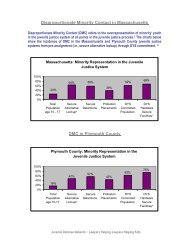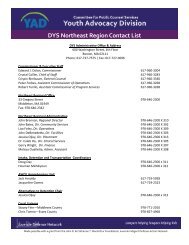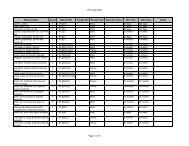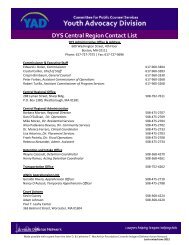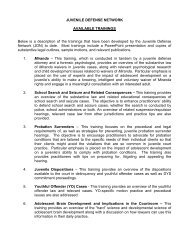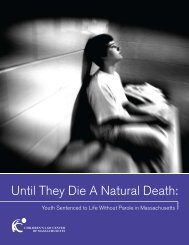States rethink 'adult time for adult crime' - the Youth Advocacy Division
States rethink 'adult time for adult crime' - the Youth Advocacy Division
States rethink 'adult time for adult crime' - the Youth Advocacy Division
You also want an ePaper? Increase the reach of your titles
YUMPU automatically turns print PDFs into web optimized ePapers that Google loves.
simply exhibiting images of Weinstein’s brain in court would sway <strong>the</strong> jury.<br />
Eleven days later, on <strong>the</strong> morning of jury selection, <strong>the</strong>y agreed to let Weinstein<br />
plead guilty in exchange <strong>for</strong> a reduced charge of manslaughter.<br />
After <strong>the</strong> Weinstein case, Daniel Martell found himself in so much demand to<br />
testify as a expert witness that he started a consulting business called Forensic<br />
Neuroscience. Hired by defense teams and prosecutors alike, he has testified over<br />
<strong>the</strong> past 15 years in several hundred criminal and civil cases. In those cases,<br />
neuroscientific evidence has been admitted to show everything from head trauma<br />
to <strong>the</strong> tendency of violent video games to make children behave aggressively. But<br />
Martell told me that it’s in death-penalty litigation that neuroscience evidence is<br />
having its most revolutionary effect. “Some sort of organic brain defense has<br />
become de rigueur in any sort of capital defense,” he said. Lawyers routinely<br />
order scans of convicted defendants’ brains and argue that a neurological<br />
impairment prevented <strong>the</strong>m from controlling <strong>the</strong>mselves. The prosecution<br />
counters that <strong>the</strong> evidence shouldn’t be admitted, but under <strong>the</strong> relaxed<br />
standards <strong>for</strong> mitigating evidence during capital sentencing, it usually is. Indeed,<br />
a Florida court has held that <strong>the</strong> failure to admit neuroscience evidence during<br />
capital sentencing is grounds <strong>for</strong> a reversal. Martell remains skeptical about <strong>the</strong><br />
worth of <strong>the</strong> brain scans, but he observes that <strong>the</strong>y’ve “revolutionized <strong>the</strong> law.”<br />
The extent of that revolution is hotly debated, but <strong>the</strong> influence of what some call<br />
neurolaw is clearly growing. Neuroscientific evidence has persuaded jurors to<br />
sentence defendants to life imprisonment ra<strong>the</strong>r than to death; courts have also<br />
admitted brain-imaging evidence during criminal trials to support claims that<br />
defendants like John W. Hinckley Jr., who tried to assassinate President Reagan,<br />
are insane. Carter Snead, a law professor at Notre Dame, drafted a staff working<br />
paper on <strong>the</strong> impact of neuroscientific evidence in criminal law <strong>for</strong> President<br />
Bush’s Council on Bioethics. The report concludes that neuroimaging evidence is<br />
of mixed reliability but “<strong>the</strong> large number of cases in which such evidence is<br />
presented is striking.” That number will no doubt increase substantially.<br />
Proponents of neurolaw say that neuroscientific evidence will have a large impact<br />
not only on questions of guilt and punishment but also on <strong>the</strong> detection of lies<br />
and hidden bias, and on <strong>the</strong> prediction of future criminal behavior. At <strong>the</strong> same<br />
<strong>time</strong>, skeptics fear that <strong>the</strong> use of brain-scanning technology as a kind of super





